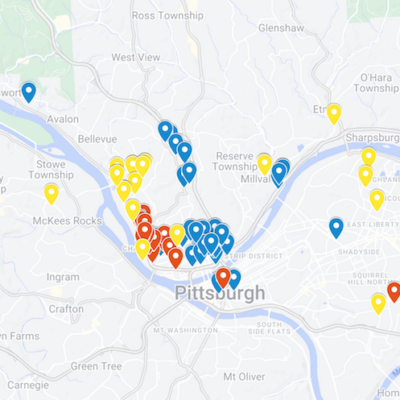
Woods Run is the colloquial name for a section of the present Marshall-Shadeland neighborhood of the North Side of Pittsburgh, named for a local creek and watershed. In the early 20th century, Woods Run included an immigrant working-class enclave in a plain between the tracks of the Pittsburgh, Ft. Wayne & Chicago Railroad and the north banks of the Ohio River. The largely industrial area was home to the campus of Western Penitentiary, the Woods Run Settlement, the Woods Run Public School, several houses of worship, a business district on Preble Avenue, and a few blocks of residential housing.
Before World War I, a small Jewish population began settling in the two blocks of the Preble Avenue business district between Eckert and Doerr streets. These were largely merchants who operated ground level stores and lived above in second-floor apartments.
Jewish families in Woods Run include Applehood, Baskin, Berkowitz, Bloom, Boyer, Cohen, Davis, Epstein, Fink, Glass, Glick, Gillis, Goldstein, Gordon, Jacobson, Leavitt, Lefkowitz, Lefshatz, Levine, Liptz, Markowitz, Neaman, Olansky, Pann, Persky, Portnoy, Rabinowitz, Riner, Rudin, Sandler, Silverberg, Silverstein, Singer, Stone, and Sulkowitz. Fink, Garfinkel, Glick, Neaman, and Stone were branches of a single family.
Some of these families organized the Woods Run Congregation in the mid-1910s. The earliest documentation of the congregation is a fundraiser for the War Sufferers Relief Fund in 1916.[1]“War Sufferers Relief Fund,” Jewish Criterion, Nov. 17, 1916, p22 (online). The congregation dedicated a Torah scroll in 1922 and participated in a communitywide Yom Kippur appeal that same year.[2]“Woods Run Congregation,” Jewish Criterion, Sept. 15, 1922, p15 (online). [3]“Yom Kippur Appeal,” Jewish Criterion, Sept. 29, 1922, p19 (online). With the help of the Southwestern District of Pennsylvania Jewish Religious Schools program, the Woods Run Congregation formed a Mother’s Club and a religious school in November 1922.[4]“Religious School News,” Jewish Criterion, Nov. 3, 1922, p10 (online).
The Woods Run Congregation typically met at the nearby Woods Run Settlement at 3033 Petosky Street. Through the 1920s, the Woods Run Mother’s Club held monthly meetings at the homes of members in Woods Run, as well as the homes of relatives in other parts of the region, including Etna, Millvale, Highland Park, and Squirrel Hill.
The Woods Run Religious School dissolved sometime after June 1928, when students began attending the religious school associated with Congregation Beth Jehuda in nearby Manchester.[5]“Congregation Beth Jehuda of Manchester,” Jewish Criterion, Nov. 9, 1928, p27 (online). By the late 1930s, only a few Jewish families were living in Woods Run.[6]Kuntz, Leonard Irvin, “The Changing Pattern of the Distribution of the Jewish Population of Pittsburgh From Earliest Settlement to 1963.” (1970). LSU Historical Dissertations and Theses. 1864. … Continue reading
Woods Run was also home to Western State Penitentiary, which had a transient Jewish population throughout its existence. In the mid-1920s, the local B’nai B’rith sponsored the creation of a small Jewish chapel at the facility for the local Congregation Agudas Achim.
References
| ↑1 | “War Sufferers Relief Fund,” Jewish Criterion, Nov. 17, 1916, p22 (online). |
|---|---|
| ↑2 | “Woods Run Congregation,” Jewish Criterion, Sept. 15, 1922, p15 (online). |
| ↑3 | “Yom Kippur Appeal,” Jewish Criterion, Sept. 29, 1922, p19 (online). |
| ↑4 | “Religious School News,” Jewish Criterion, Nov. 3, 1922, p10 (online). |
| ↑5 | “Congregation Beth Jehuda of Manchester,” Jewish Criterion, Nov. 9, 1928, p27 (online). |
| ↑6 | Kuntz, Leonard Irvin, “The Changing Pattern of the Distribution of the Jewish Population of Pittsburgh From Earliest Settlement to 1963.” (1970). LSU Historical Dissertations and Theses. 1864. (online—LSU Historical Dissertations and Theses). |